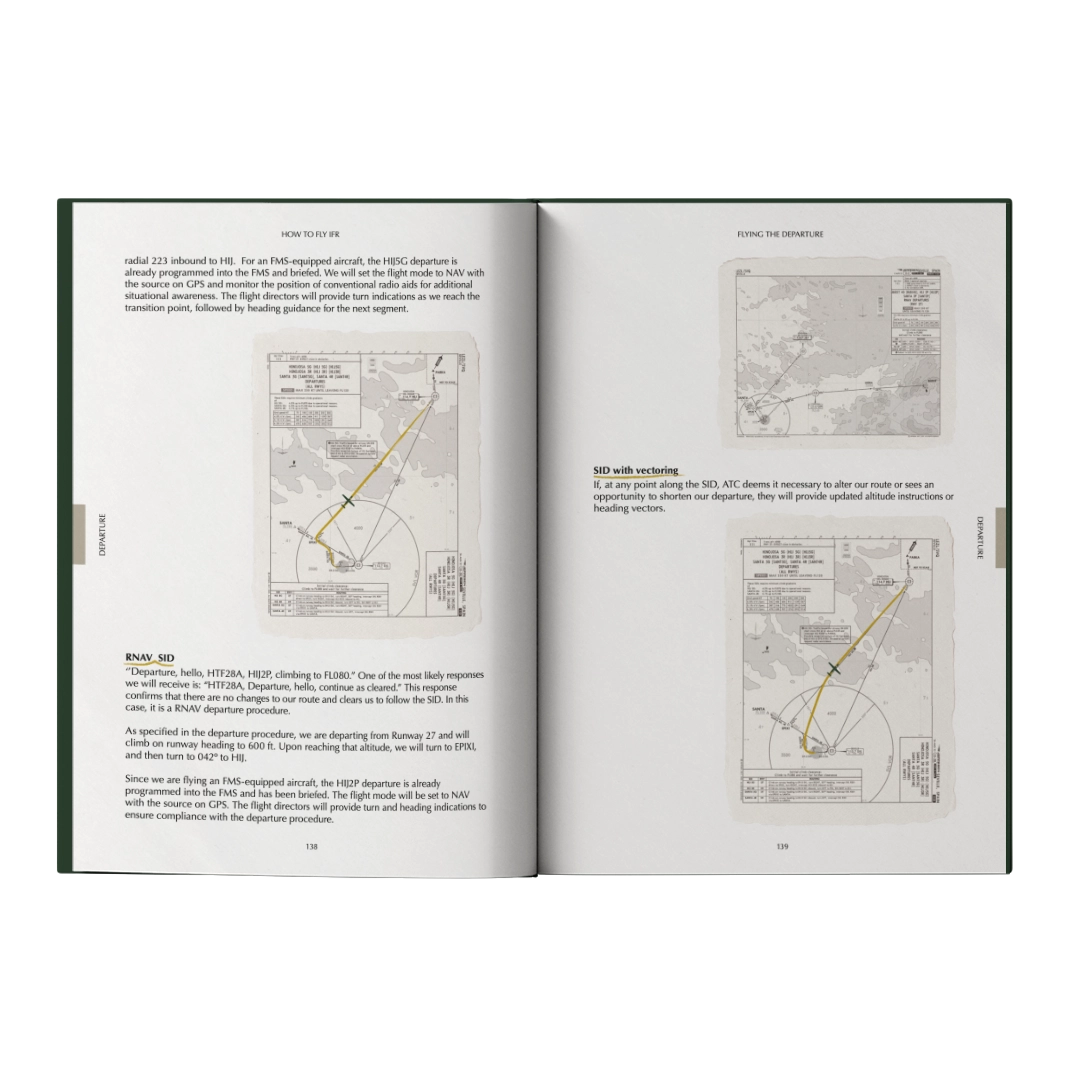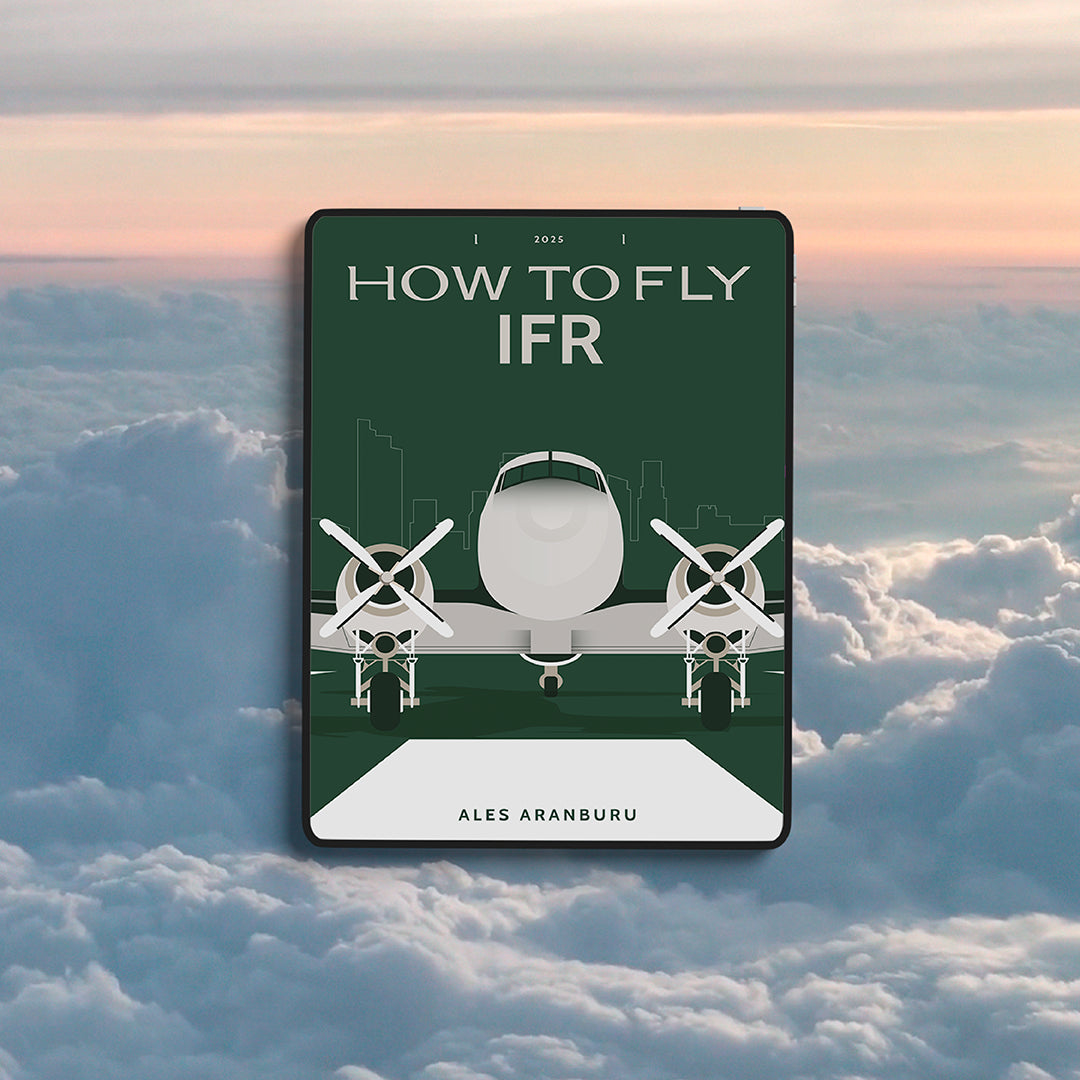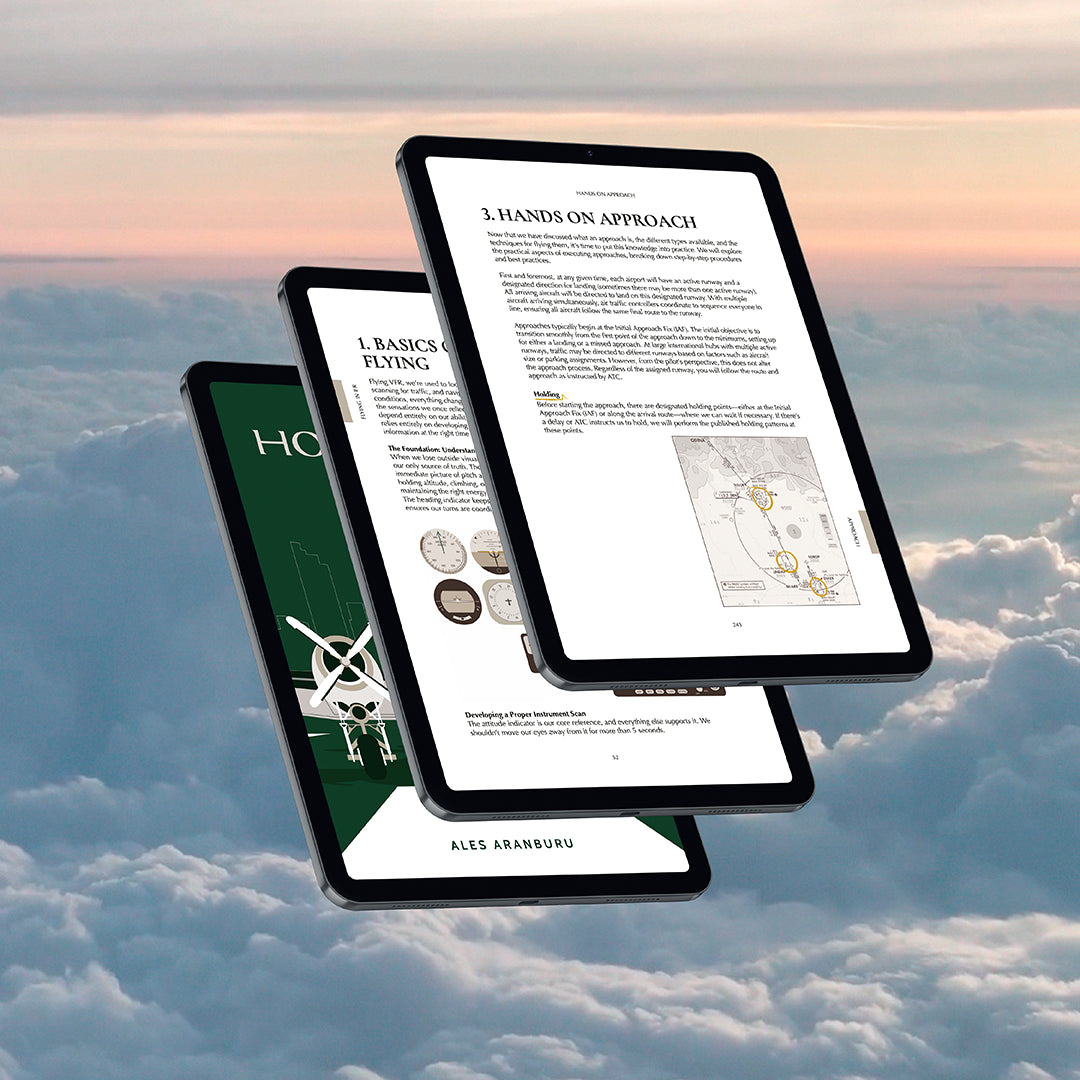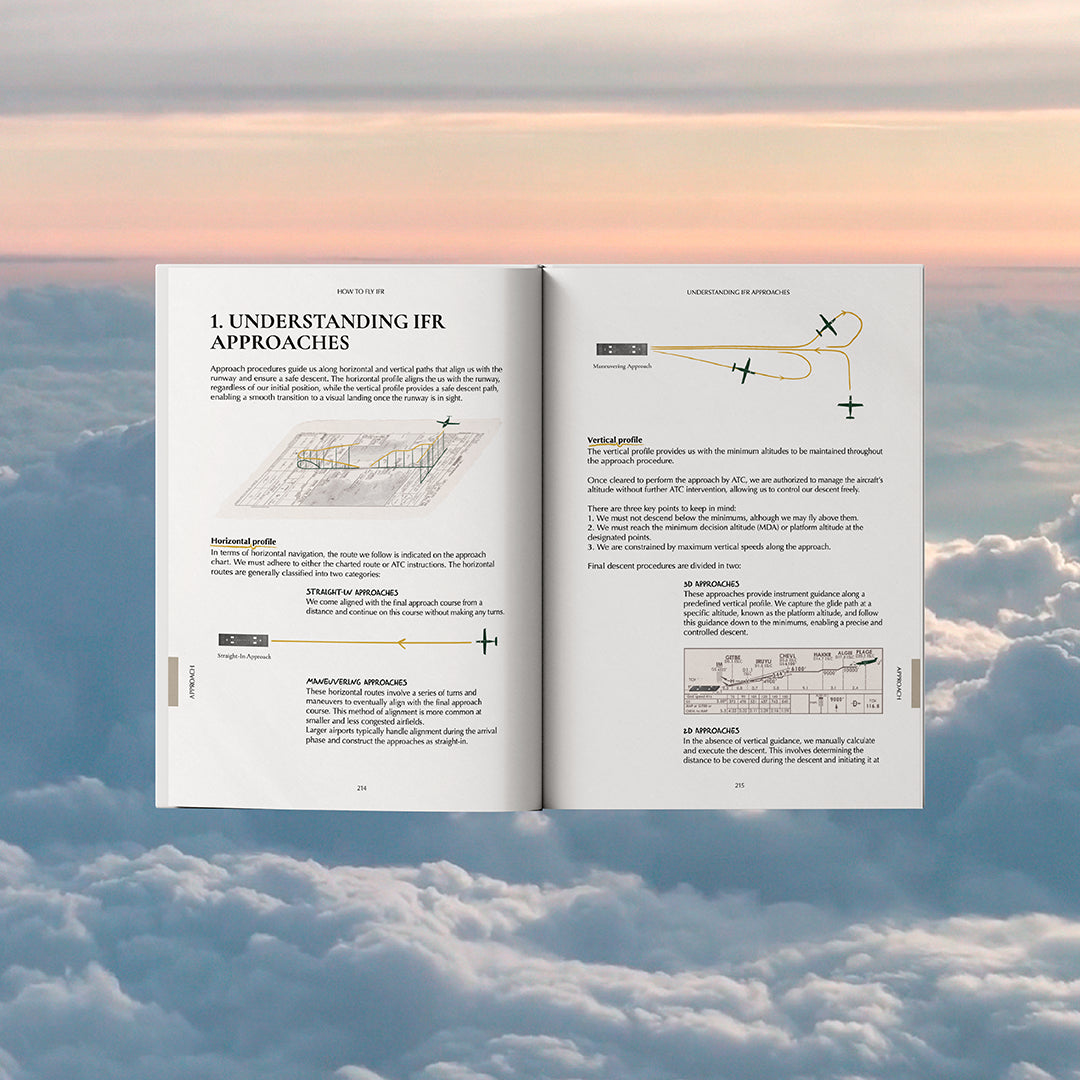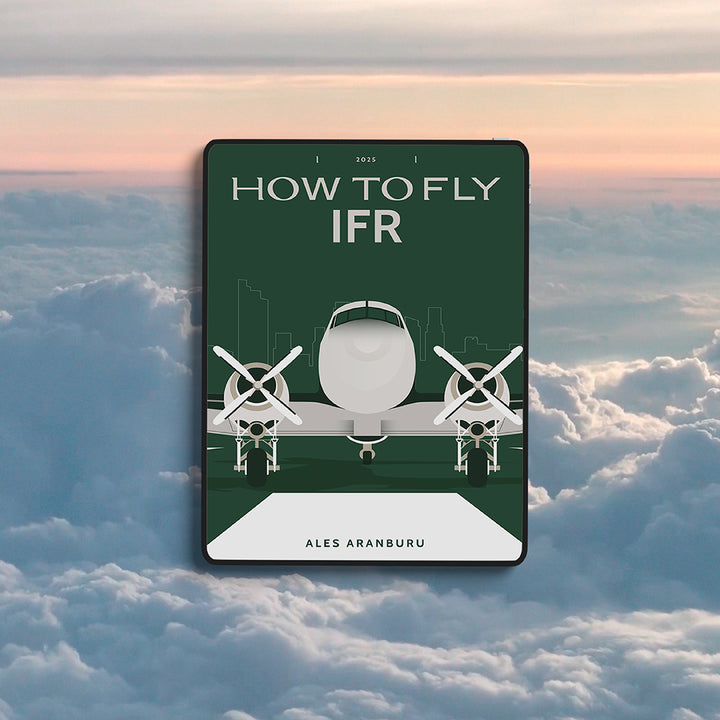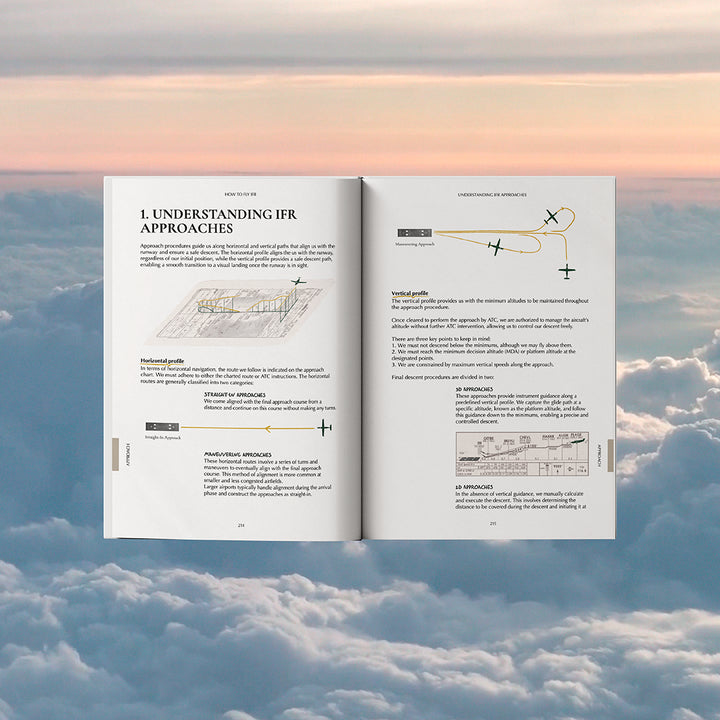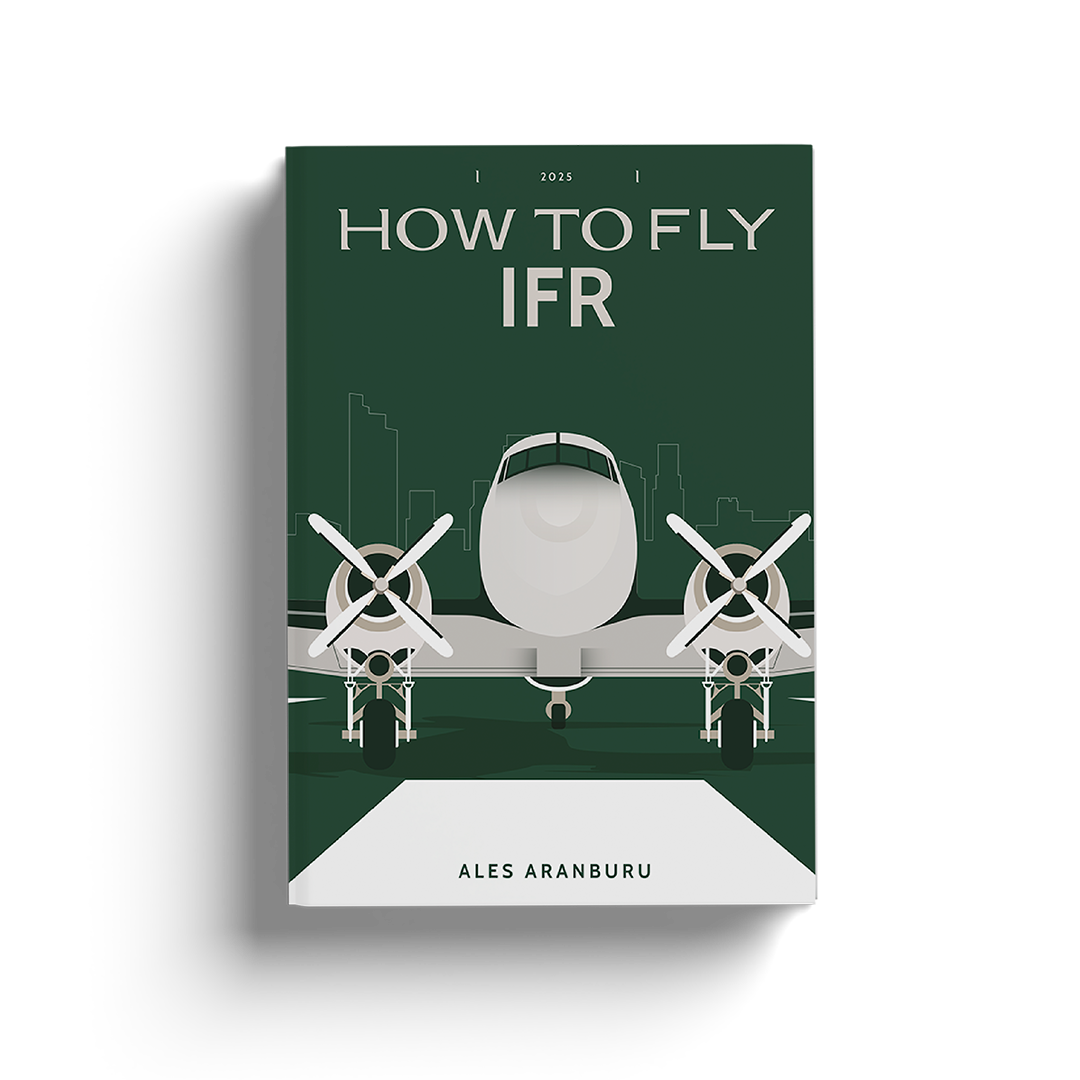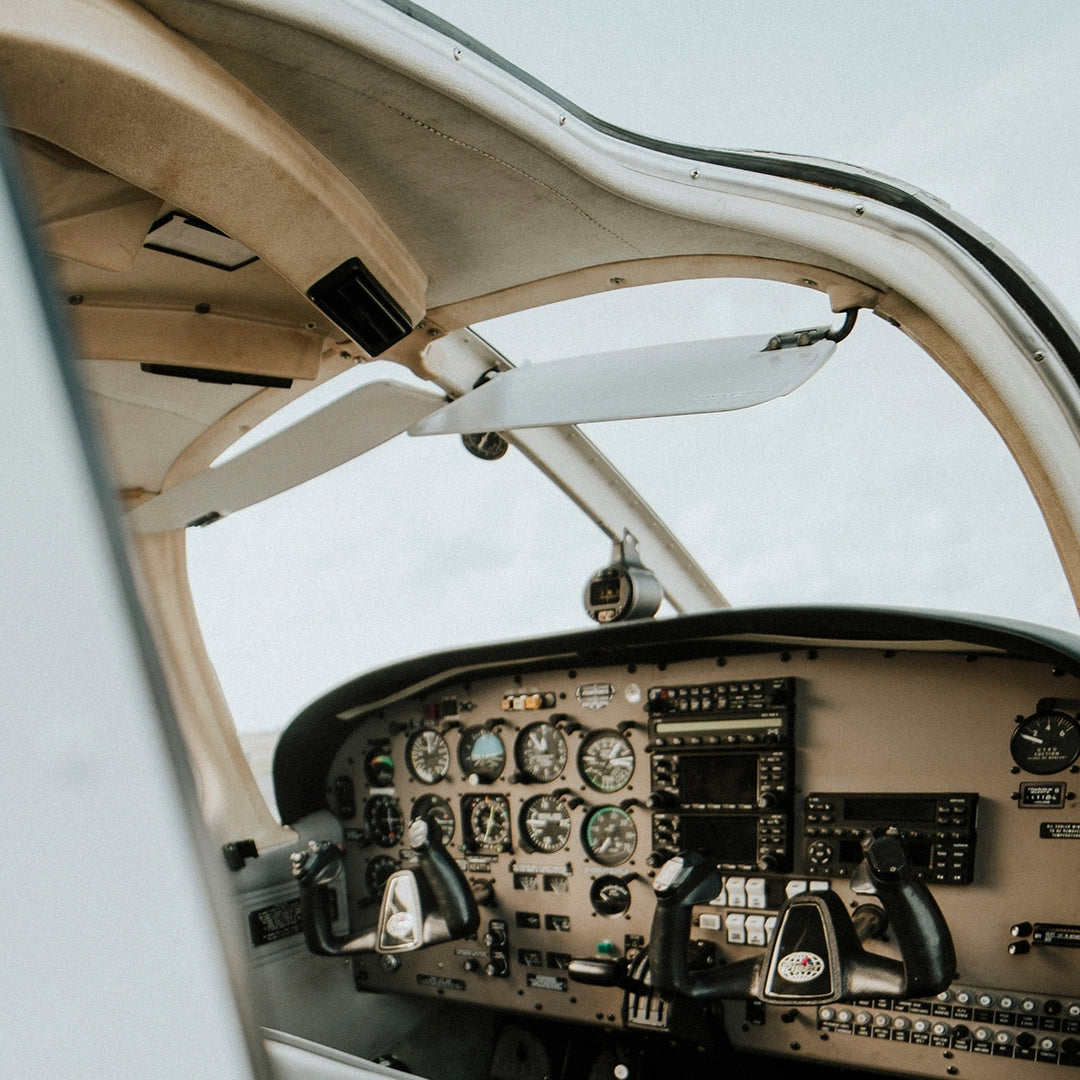
master ifr
Starting from the basics.
Master every equipment, instrument, and screen. Our guide simplifies IFR, providing clear and concise explanations for each action.
Even if you have never performed a IFR procedure in real life.
Explained in a unique way, we made sure you understand how everything works.
TABLE OF CONTENTS
Discover what each chapter covers: from cockpit equipment and flight planning, to departures, arrivals, approaches, and everything in between.
This is the introductory chapter of the book, the starting point for anyone who wants to understand what IFR really is.
You’ll learn the core principles of instrument flying, why it’s so important for safety, and how it enables pilots to operate confidently in clouds, at night, or at high altitude.
The chapter also gives you a clear overview of a typical IFR flight from start to finish, so you see the big picture before diving into the details.
Discover the cockpit. No matter if you are flying a 1967 Piper, a brand new Cirrus with G1000 or big airliners. We got you covered. The next time you jump in a cockpit, you will feel at home.
This chapter walks you through every cockpit setup and navigation aid, showing not just what they do, but how you’ll use them in real IFR flying. After this, you’ll never feel lost in an unfamiliar cockpit again.
Cockpit
- Fully analog: Learn the classic “six-pack” and understand how to fly confidently with needles and dials.
- Hybrid: Discover how analog panels integrate GPS/FMS for more flexibility.
- Electronic (glass cockpit): See how modern displays condense critical data and speed up your instrument scan.
- Autopilot: Understand every lateral and vertical mode so you can reduce workload while staying in control.
Navigation Equipment
- NDB: Old but still in use—know how it works and when to rely on it.
- VOR: Learn radial tracking and interception, the backbone of IFR routes.
- DME: Use precise distance and time-to-station info for situational awareness.
- ILS: Precision down to the runway—master localizer and glide slope indications.
- RNAV: Fly direct routes with GPS and FMS, unlocking the efficiency of modern IFR.
By the end, you’ll be able to step into any IFR cockpit—old trainer or high-tech turbine—and know exactly how to use the equipment to keep your flight safe and efficient.
This chapter teaches you how to see through the panel, turning complex procedures into simple, repeatable techniques. You’ll learn to trust your instruments more than your senses and navigate with precision, no matter the conditions.
Instrument Scanning
- Build a reliable scan so nothing slips by unnoticed. Avoid fixation and learn techniques that keep you ahead of the airplane.
Determining Location
- Use VORs, DMEs, and RNAV waypoints to pinpoint exactly where you are. Cross-check systems so you never second-guess your position.
Radial Interception
- Capture inbound and outbound courses smoothly. Learn proven intercept angles and wind correction tricks.
DME Arc
- A step-by-step method to fly DME arcs without stress. Control drift and distance like a pro.
IFR Flight Overview
- Understand the big picture: departure, enroute, arrival, approach. Know what to expect at every phase so nothing surprises you.
You’ll come out of this chapter with a pilot’s “instrument vision”—able to know here you are, fly headings, courses, arcs, and procedures confidently, even in total white-out.
In this chapter, you’ll learn how to plan like an airline captain—anticipating weather, routes, alternates, and fuel so you’re always two steps ahead. No guesswork, no last-minute surprises: just a solid plan you can trust in the air.
Overview
- Get the big picture of IFR planning: from route selection to contingency thinking.
Weather
- METARs, TAFs, winds aloft, and hazards. Anticipate icing, turbulence, and storms before you’re in them.
NOTAMs
- Spot runway closures, nav aid outages, and restrictions that could affect your flight.
Alternate Selection
- Apply the rules for choosing alternates. Learn how to balance distance, weather, and available approaches.
Procedures
- Understand SIDs, STARs, and approach plates as part of your plan.
Route Planning
- Work with preferred routes and digital planning tools. Optimize efficiency while staying ATC-friendly.
Fuel Planning
- Calculate trip, reserve, contingency, and alternate fuel precisely. Avoid the stress of “minimum fuel” calls.
Mass and Balance
- Learn how to keep your aircraft within safe limits for every flight.
Operational Flight Plan (OFP)
- Create a professional-grade flight plan you can brief and fly with confidence.
Filing Your Flight Plan
- File electronically or by phone—know both systems. Avoid common errors.
After this chapter, you’ll know exactly how to prepare an IFR flight that is safe, legal, and efficient—so the real flying feels effortless.
This chapter is about building confidence before the wheels even leave the tarmac. You’ll learn how to prepare yourself, your paperwork, and your aircraft—then transition to startup, cockpit setup, clearance, and taxi until you’re lined up, ready for departure.
Proficiency and Currency
- Stay sharp with the latest IFR requirements. Learn the checks that prove you’re fit and legal to fly passengers.
Day of Flight – Checks
- Pre-flight weather briefing: METARs, TAFs, SIGMETs, PIREPs. Review NOTAMs and approach segments so nothing surprises you later. IMSAFE and PAVE checklists to ensure you are ready, not just the aircraft.
Heading to the Airport
- Collect your clearance in towered airports, or learn how to coordinate at uncontrolled fields. Reach the aircraft, handle documents, and complete a thorough walkaround.Perform cockpit setup—loading the FMS, tuning radios, and preparing for IFR operations.
Ground Operations
- Engine start and after-start flows. Picking up IFR clearance: know the difference between towered vs. untowered procedures. Taxi techniques: staying safe, clear, and efficient even in low visibility. Final line-up checks before takeoff: lights, trim, and instruments.
By the end of this chapter, you’ll be able to transition from briefing room to runway threshold with total confidence—no confusion about procedures, clearances, or checklists. You’ll know exactly what to do in both controlled and uncontrolled airports, and be perfectly set up to focus on the departure ahead.
The departure sets the tone for the entire IFR flight. This chapter shows you how to go from “ready for departure” to safely established enroute—whether you’re flying from a major international airport with complex SIDs or a small uncontrolled field with no published procedures.
Understanding the SID
- Learn how Standard Instrument Departures are designed. Read and brief SID charts with ease. Understand conventional vs. RNAV departures and the nav aids behind them.
Preparing the Departure
- Load the procedure into your FMS or set up raw-data radios in analog cockpits.Calculate climb gradients and review threats before taxi.Use structured briefing frameworks so nothing is forgotten.
Flying the Departure
- Perform takeoff roll, gear-up, and initial climb with precision. Manage autopilot modes (HDG, NAV, VNAV) step by step. Adapt when ATC issues vectors or shortcuts. Learn omnidirectional departures and IFR joinings from non-towered airports.
After this chapter, you’ll know exactly how to transition from runway to enroute structure—confidently handling ATC instructions, following complex procedures, and ensuring obstacle clearance without stress.
This chapter shows you how to manage performance, coordinate with ATC, and stay ahead of the airplane until it’s time to descend.
Leveling Off
- Smooth techniques to capture altitude without overshooting. Set cruise power and confirm fuel burn matches your plan. Monitor systems, pressurization, and instruments.
Routing Changes
- How to request directs for shorter flights and less fuel burn. Manage reroutes and vectoring while staying ahead of ATC.
Altitude Changes
- Request climbs or descents to optimize winds or avoid turbulence. Handle step-climbs as the aircraft gets lighter.
Icing Conditions
- Detect subtle signs of ice buildup early. Use anti-ice systems correctly and know escape strategies.
Preparing the Descent
- Calculate Top of Descent using the 3° rule or FMS. Program STARs and approaches into the FMS.Conduct arrival, approach, and taxi briefings while still in cruise.
You’ll turn long stretches of flight into opportunities to optimize efficiency, stay ahead of weather, and prepare for the busiest phase—the arrival.
This chapter takes you step by step from cruise altitude down into terminal airspace, showing you how to stay efficient, legal, and safe while juggling charts, altitudes, and ATC clearances.
Understanding the STAR
- Learn how arrivals are designed and why they matter. Read STAR charts confidently: waypoints, altitude constraints, and speed limits.Conventional vs. RNAV STARs in analog and glass cockpits.
Preparing the Arrival
- Gather weather, calculate top of descent, and brief the full procedure. Learn descent profiles and how to manage vertical and horizontal planning. Transition levels, FL100 checks, and descent configuration differences in analog vs. automated cockpits.
Flying the Arrival
- Handle conventional STARs, RNAV STARs, or vectoring from ATC. Manage speed, descent rates, and traffic in congested airspace. Techniques for STAR-less airports or when cancelling IFR into a VFR field.
Holdings
- Entry procedures made simple: direct, parallel, and teardrop. Tips for adjusting patterns depending on wind and position. Tricks to stay oriented and precise in the stack.
You’ll approach every airport with confidence—able to brief, descend, hold, and fly the arrival smoothly, no matter how busy the airspace or how poor the weather.
In this chapter, you’ll learn how to set up, brief, and fly any type of IFR approach—whether you’re on old-school analog needles or a modern glass cockpit with full automation.
Breaking Down the Approach
- Understand each segment—initial, intermediate, final, and missed approach—and what’s expected in each. Straight-in vs. maneuvering: when to use them, and how to prepare for both. Visualize vertical and horizontal profiles before you even begin descending.
Types of Approaches
- Conventional: ILS, LOC, NDB, and VOR approaches explained in depth. RNAV: LPV, LNAV/VNAV, LNAV, and LP approaches—what they are and how they work. Learn exactly what your instruments will show you, and how to read them quickly.
Preparing the Approach
- Weather: ceilings, visibilities, crosswinds—know your limits and the aircraft’s.Aircraft: flap settings, gear extension, and speeds for every category. Descent planning: simple techniques to calculate TOD for both 2D and 3D profiles. Taxi and runway exit planning so the workload doesn’t spike after touchdown. The legal side: rules and minima you must respect before committing to an approach.
Setting Up the Cockpit
- Analog: radios, nav aid identification, and OBS settings.Glass: programming the FMS, selecting the approach, and arming the correct modes.Smart redundancy: backup setups that keep you safe if one system fails.Master the art of a complete, professional approach briefing.
Flying the Approach
- Pre-approach check: weather, traffic, and equipment readiness.Initial & intermediate: intercepting smoothly, managing descent rates, and setting speeds.Final: stabilize with gear and flaps, monitor glidepath, and stay ahead of minima.Using autopilot and flight director effectively without over-relying on them.Handling workload: fly, monitor, brief—without skipping a beat.
The Landing Decision
- Spotting the visual cues at DA/MDA: approach lights, PAPI/VASI, runway markings.Straight-in landings: a clean transition from instruments to visuals.Circling: safe maneuvering at low altitude when straight-in isn’t possible.Always ready for the go-around: how to execute missed approaches without hesitation.
This chapter gives you the most important IFR skill—the ability to fly approaches with absolute confidence. You’ll learn to brief clearly, set up any cockpit, and fly procedures with accuracy, so that even in low visibility or high workload, your landing feels like a calm, repeatable process—not a gamble.
The flight doesn’t end at touchdown. In this chapter, you’ll learn the essential steps to bring the airplane safely from rollout to shutdown, while keeping things professional and stress-free.
Runway Exit
- Vacating quickly and safely, even at complex airports. Communicating with ATC while keeping situational awareness.
Taxiing
- Follow taxi charts and navigate large international hubs, avoiding all dangers and disorientation.
Shutdown & Securing
- Engine shutdown flows and after-landing checks. Parking procedures and final paperwork.
Getting to Know the Destination
- Enjoy the reward: a chance to relax, explore, and maybe celebrate the flight with a well-earned drink.
You’ll finish every flight with no loose ends—ready to relax, debrief, and enjoy your destination.
Flying ahead of your aircraft
has never been this simple
“How to Fly IFR” is the book I wish I had when I started with IFR. But it turns out I still use it.
The book is structured as the flight unfolds, including each flight phase and all the different variations you will find.
This is all the IFR knowledge a pilot needs.
a complete ifr flight, step by step
down to the last button press
Discover all the practical IFR knowledge as we jump into a flight from Denver to Salt Lake City *FAA (Seville to Milan *EASA).
We will explore all the possible procedures, including conventional, RNAV and visual procedures, on analog and glass cockpit, and flying manually or with automation.
From planning to engines shut down.
It's a bunch, it's everything.
And its all condensed in a flight-bag-friendly format.
Yes, this book was written for myself, and I'm sure it will be helpful to you.
Be Ready to Operate in Any Airport, Big or Small
Equip yourself with the knowledge to handle the unique challenges of any airfield.
Whether you are flying into an international hub with several transitions in arrival, or from a small grass field with an IFR pickup, this book will allow you to go to any airport full of confidence, regardless of its size.

REVIEWS
lightning fast flight planning
Streamline your flight planning with our step by step guide.
This book will guide you through a structured planning method that's not only quick, but also will make sure your flight planning is complete.
From weather assessments to fuel calculations, you'll learn to go over every essential step.


Understand Why We Do Procedures
Go beyond the "how" and dive into the "why" of procedures.
The procedures are explained in a way that clarifies the reasoning behind each standard operation.
This is essential to transition from one aircraft to another seamlessly.
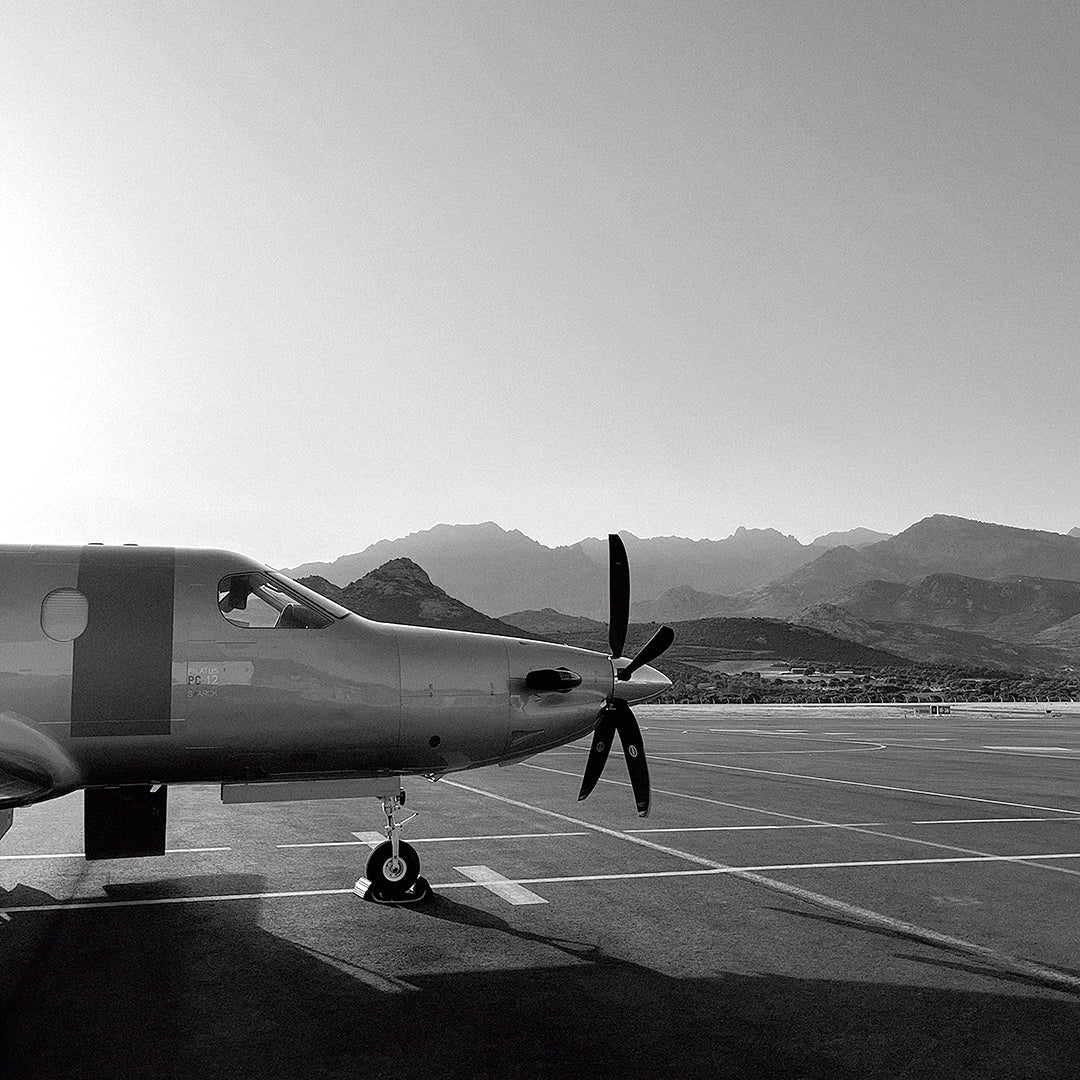
Make Sure You Have Everything You Need Onboard to Go to the Air
Before you taxi out, it's crucial to ensure that your aircraft is fully prepared for the flight ahead. This chapter covers all the essentials you need to verify while still on the ground.
From confirming that all necessary documents and manuals are on board to checking the weather and departure route.
Learn the how to perform a thorough pre-flight inspection, from fuel levels and oil checks to instrument settings.
Briefings
Briefings are essential, and if you are unlucky with your colleague, eternal. Ensure every procedure is a success with our comprehensive briefing guide.
Learn to condensate essential information, from runway conditions to emergency procedures, into a dynamic and actionable briefing.
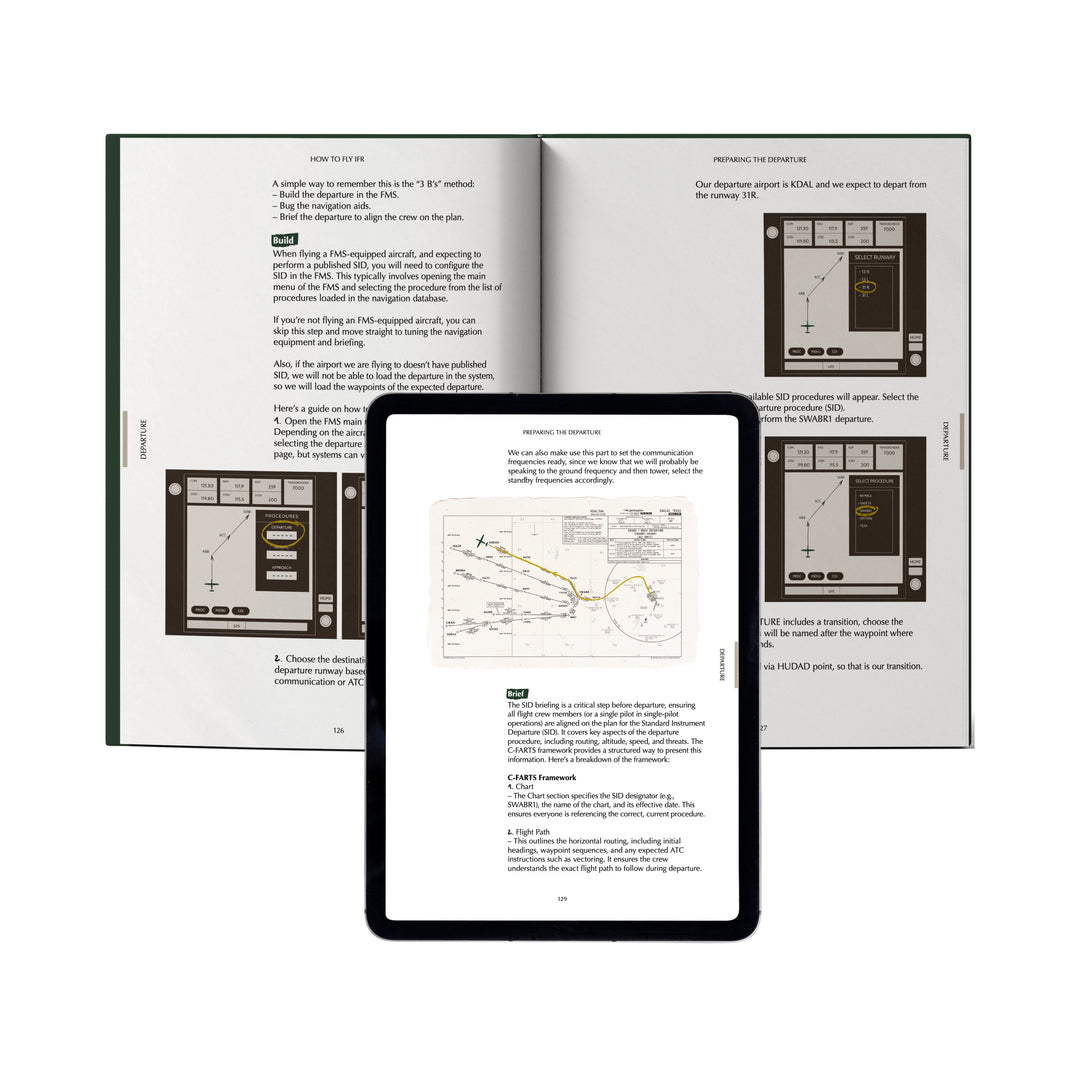
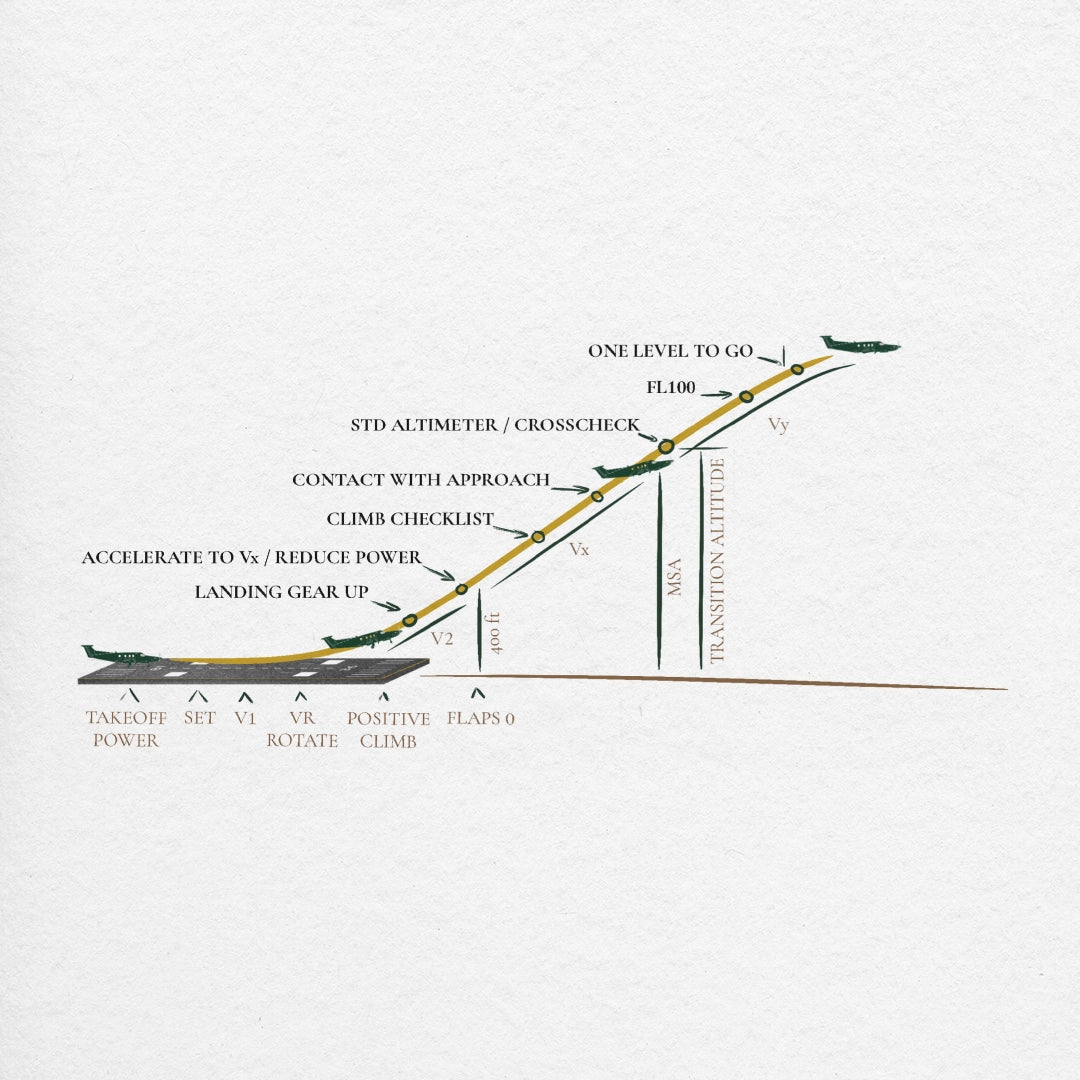
Every Step of the Takeoff and Callouts
This chapter details every phase of the departure.
Master the critical stages of takeoff, from runway identification to gear retraction and initial turn, accompanied by the necessary callouts.
Understand the Charts
Fly Standard Instrument Departures (SID) with ease.
This part of the book decyphers SID charts, helping you interpret and follow the routing information.
With practical tips and clear illustrations, you'll manage departures, maintaining safety and efficiency in controlled airspace.
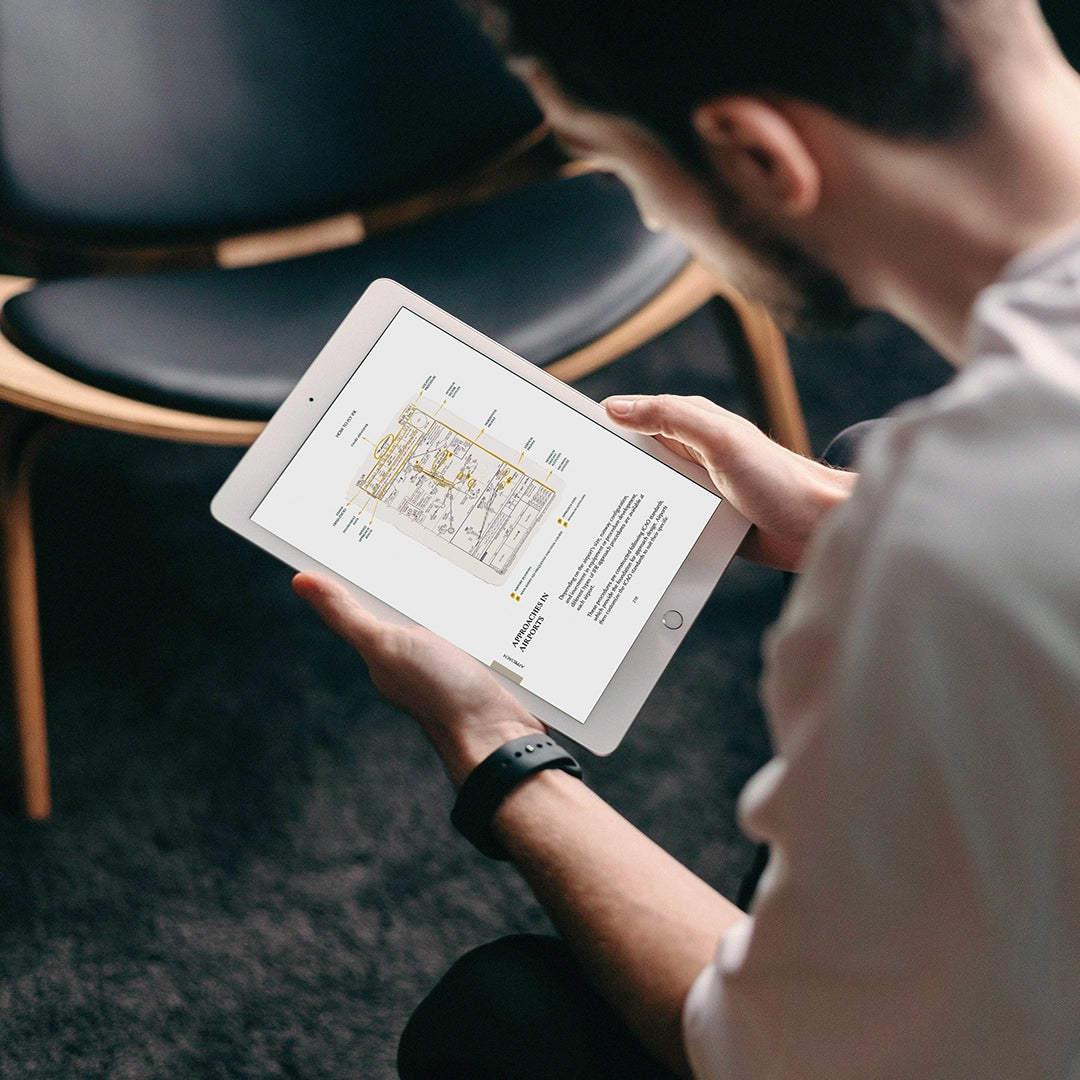

TALK TO ATC
Talk to ATC without freezing.
This section equips you with the most commong phrasing and typical responses during departure.
Understand the expectations and directives from ATC, ensuring your communications are clear, concise, and correct.
Omnidirectional Departures and IFR Joinings
Handle departures without a Standard Instrument Departure (SID) route.
Learn to execute omnidirectional departures and join controlled IFR routes from uncontrolled airports.
